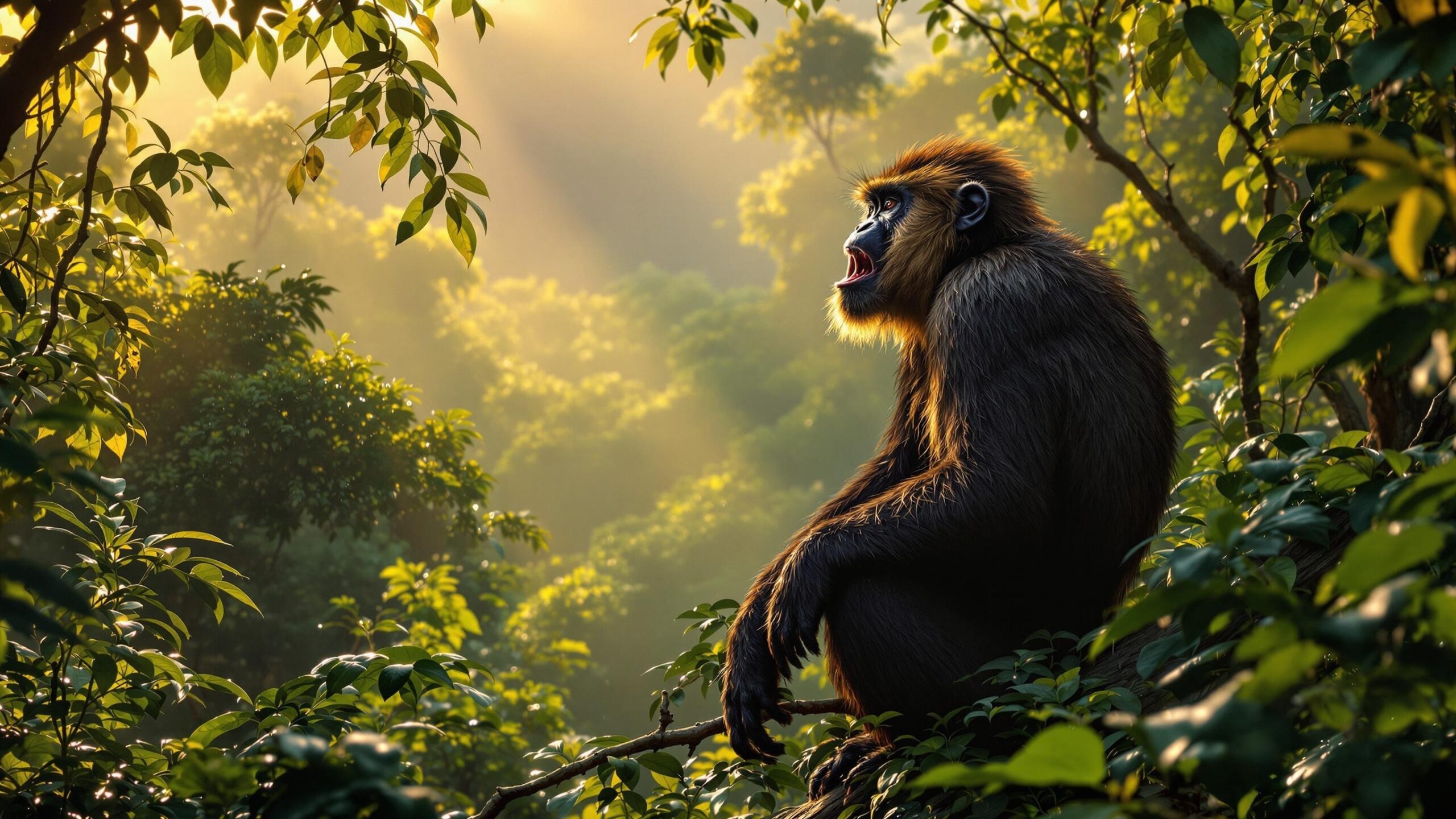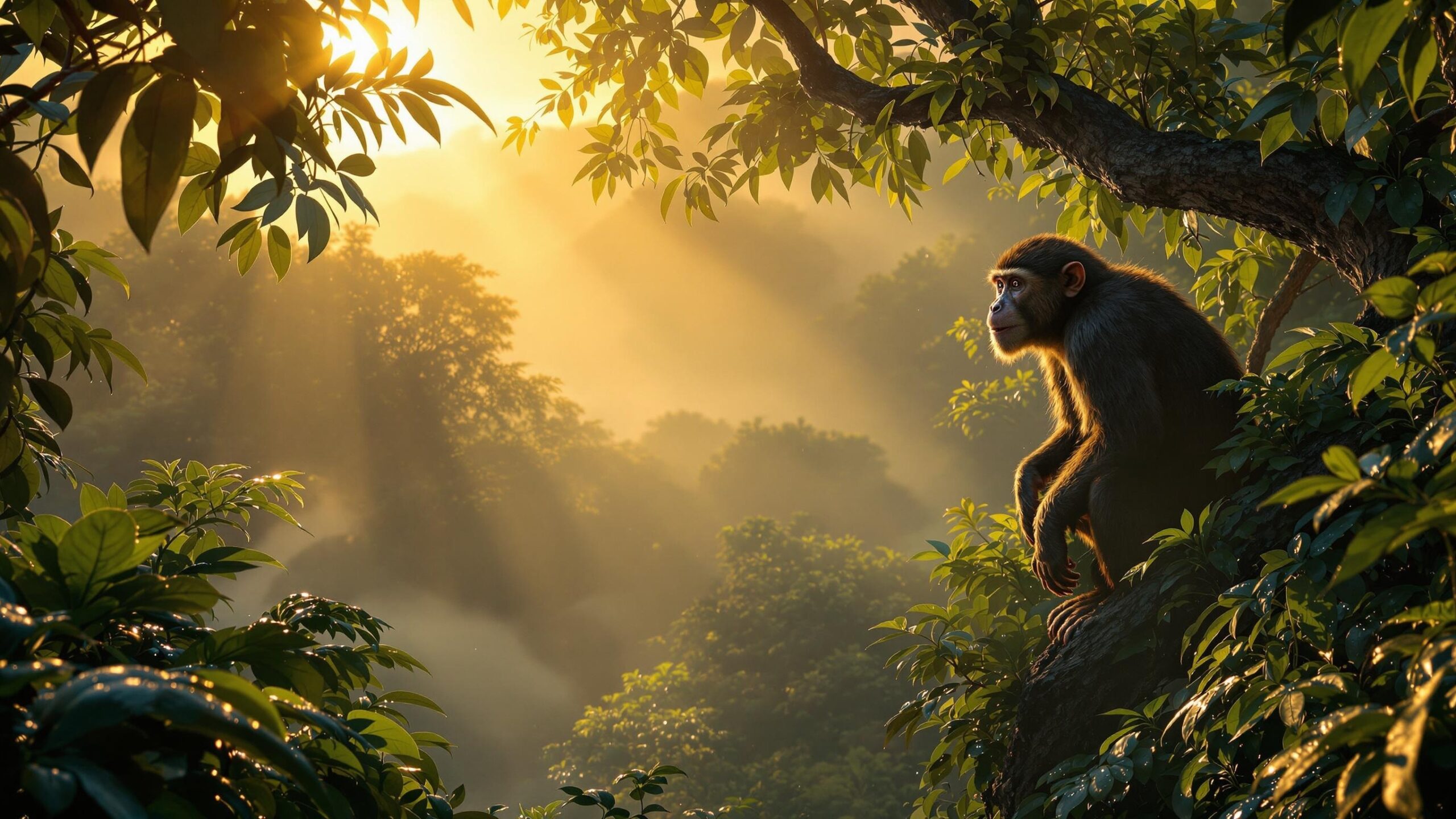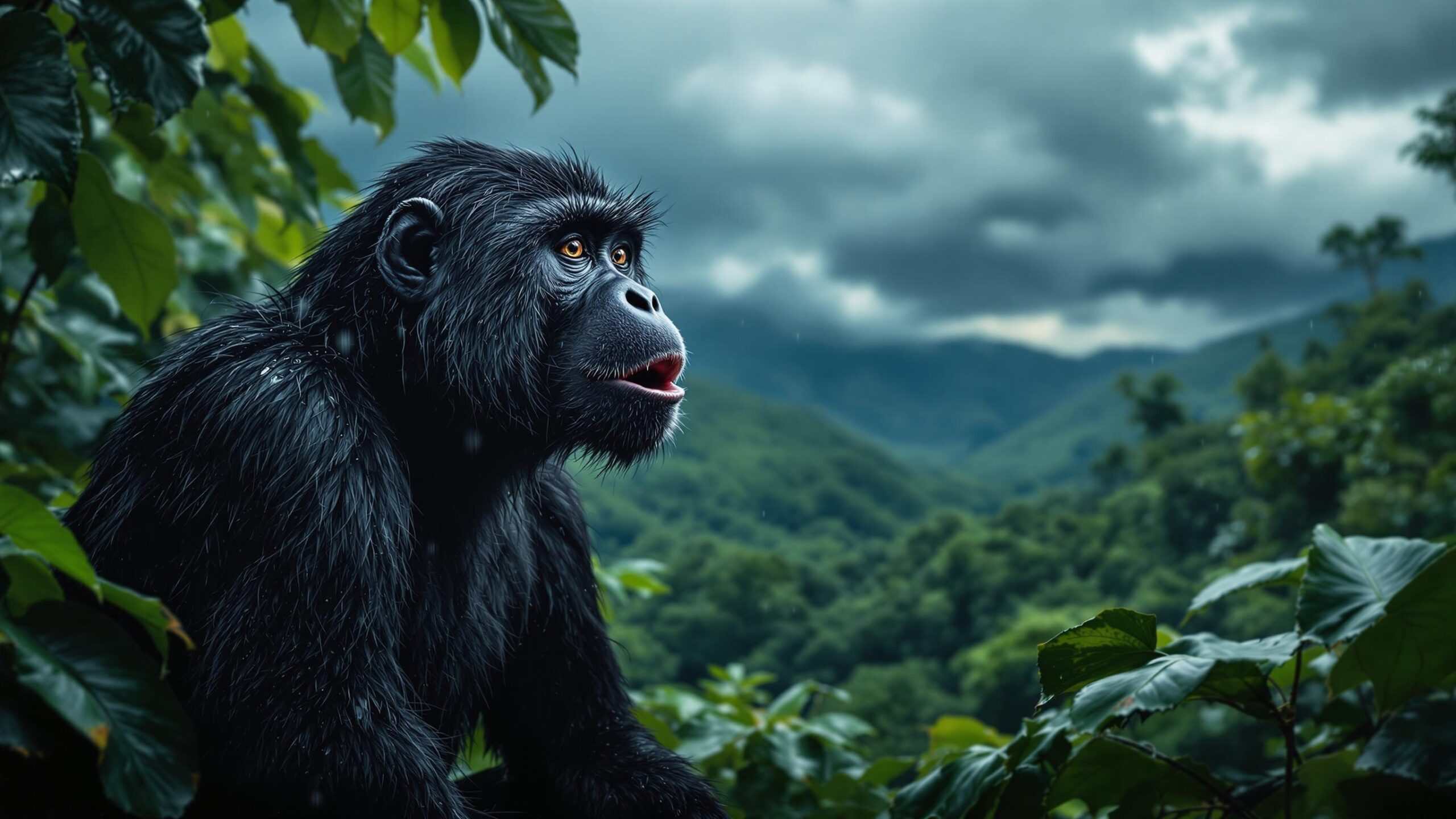Howler Monkey (Alouatta): The Echoing Voice of the Jungle
As dawn breaks over the rainforests of Central and South America, a deep, resonating roar cuts through the morning mist. It echoes for miles, vibrating through the canopy like a prehistoric trumpet. This is the unmistakable voice of the Howler Monkey, one of nature’s loudest land mammals and a true icon of the neotropical wilderness. Known for their booming calls, tree-top agility, and social complexity, howler monkeys are a vital part of the forest tapestry—and a marvel of evolutionary adaptation.
Belonging to the genus Alouatta, howler monkeys are a diverse group of New World primates known not only for their vocal prowess but also for their strong social bonds, prehensile tails, and crucial role in maintaining forest health. Though often heard before they’re seen, these monkeys are deeply woven into the ecosystems and cultures of the Americas. In this comprehensive article, we’ll explore the biology, behavior, ecology, and conservation status of howler monkeys—offering a full picture of what makes them both fascinating and essential to their environment.
Physical Characteristics: Powerful Voices and Prehensile Precision
Howler monkeys are medium to large-sized primates, with adult males weighing between 15 to 22 pounds and females slightly smaller. They possess muscular, stocky builds, long limbs for agile climbing, and dense, shaggy fur ranging in color from black to reddish-brown depending on the species. Their most distinctive physical feature is their enlarged hyoid bone, located in the throat. This bone acts like a resonating chamber, enabling their thunderous vocalizations that can travel for three miles through dense forest.
Their faces are often hairless with deep-set eyes and expressive brows, giving them a perpetually contemplative appearance. But perhaps their most remarkable tool is the prehensile tail—a fifth limb of sorts. Strong, flexible, and covered with a tactile pad on the underside, this tail is used for gripping branches, hanging while feeding, and maintaining balance as they move through the canopy. With their specialized adaptations, howler monkeys are true arboreal specialists, rarely descending to the forest floor. Everything about them—from their limbs to their tail to their larynx—is designed for life among the treetops.
Species Diversity: Voices from Different Forests
The genus Alouatta includes about 15 recognized species, each adapted to different regions and environments across Central and South America. Some of the most well-known species include the Mantled Howler Monkey (Alouatta palliata), Black Howler Monkey (Alouatta caraya), and Red Howler Monkey (Alouatta seniculus).
The Mantled Howler, with its striking golden fringes and booming voice, is found in countries from Mexico to Ecuador. The Black Howler, more common in eastern Bolivia, Brazil, Paraguay, and northern Argentina, has dimorphic coloring—males are jet black while females are blonde or tan. The Red Howler Monkey, one of the largest and loudest, inhabits the Amazon Basin and the Andean foothills. Despite differences in size, color, and range, all species of howler monkeys share core traits: social groupings, territorial behavior, frugivorous and folivorous diets, and of course, their iconic howl.
Habitat: Life in the High Canopy
Howler monkeys are found in a variety of forested habitats, including tropical rainforests, cloud forests, dry deciduous forests, and gallery forests. From the lowland Amazon to mountain slopes and riverbanks, these monkeys are remarkably adaptable as long as there is sufficient tree cover and access to food.
They are almost exclusively arboreal, spending their lives in the upper canopy and rarely venturing to the ground. This vertical lifestyle helps them avoid predators like jaguars and large snakes while taking advantage of sunlight-exposed leaves and fruit that grow high in the forest layers. Howlers establish home ranges that vary from 5 to 60 hectares depending on food availability and group size. Within these ranges, they maintain a network of feeding, sleeping, and resting sites—often reused across generations.
Diet and Foraging: Leaf-Eaters with a Flexible Palate
Howler monkeys are known as folivores, but they are best described as frugivore-folivores, with a diet that includes both fruit and leaves, along with flowers and occasional nuts. Their diet shifts with the seasons and local plant availability. In the wet season, they often consume more fruit; during dry or lean times, they rely heavily on mature and young leaves. Their digestive system is uniquely adapted to process fibrous plant material. A complex, enlarged hindgut allows for fermentation and breakdown of tough cellulose, making it possible to extract nutrients from leaves that other animals might reject.
Foraging is typically done in the early morning and late afternoon. After feeding, howlers often rest for long periods to allow digestion and conserve energy. This energy-efficient lifestyle helps them survive on a relatively low-calorie diet. Interestingly, howlers are selective eaters, often choosing leaves with high protein and low fiber-to-nutrient ratios. Their food choices influence plant growth and forest composition, making them important ecological engineers.

Social Structure: Family Groups and Hierarchies
Howler monkeys live in social groups that typically consist of 6 to 15 individuals, although group sizes can vary widely depending on the species and habitat. A typical group includes multiple adult females, their offspring, and one or more adult males. In some species, a single alpha male dominates mating, while in others, multiple males may share reproductive opportunities. The social dynamics are relatively peaceful compared to other primates. Grooming is less common, but vocal communication is frequent and important. Group members rarely engage in serious aggression, and disputes are often settled through vocal or visual displays.
Females usually remain in the group of their birth, while males tend to disperse upon maturity, seeking out new groups or forming bachelor units. This male dispersal helps prevent inbreeding and maintains genetic diversity within populations. Howlers are known for their strong maternal bonds. Infants are carried on their mothers’ bellies for the first few weeks and then transition to riding on her back. They are weaned around 12 to 18 months and remain close to their mothers until they reach juvenile independence.
Vocal Communication: Roaring in the Rainforest
The howler monkey’s name is no exaggeration. Their booming howls, produced using the enlarged hyoid bone and resonant throat sac, are among the loudest vocalizations in the animal kingdom. These calls serve several key functions: announcing territory boundaries, coordinating group movements, deterring rival groups, and maintaining contact between scattered individuals. Calling typically occurs at dawn and dusk, creating a natural chorus that echoes through the forest. The sound can travel up to three miles, especially in the still air of morning.
In addition to long calls, howlers use a variety of grunts, growls, barks, and squeals to communicate more immediate needs, such as warnings, contentment, or submission. Facial expressions and body postures also play roles in social signaling. These vocal behaviors not only define the identity of the species but help scientists study population size, distribution, and social structure without direct observation.
Intelligence and Behavior: Calm Minds in the Canopy
Howler monkeys are not as tool-oriented or manipulative as some other primates, like capuchins or chimpanzees, but they display a quiet intelligence that suits their arboreal, folivorous lifestyle. Their behavior emphasizes efficiency, memory, and observation rather than experimentation or high-energy play. They have excellent spatial memory, enabling them to remember fruiting trees and safe travel routes across complex forest terrains. They also show problem-solving abilities in group movement, foraging strategy, and conflict resolution.
Although not overtly curious, howlers are highly observant. In field studies, they’ve been noted watching human researchers for extended periods, tracking their movements with quiet attention. In captive settings, they show awareness of routine and environment, responding to changes in caretakers or schedules. Their low-energy lifestyle and reliance on group cohesion and vocal communication are adaptations to a dietary and ecological niche that rewards patience, timing, and subtlety over brute strength or flash.
Reproduction and Lifecycle: Raising the Next Generation
Reproduction in howler monkeys is a slow and careful process. Females typically give birth to a single infant after a gestation period of about six months. Births can occur year-round, although in some regions they are more common during the rainy season when food is abundant. Mothers provide all parental care, carrying the infant for months and nursing for over a year. The bond between mother and offspring is deep and lasting, with juveniles often staying in close proximity until they reach adolescence. There is no paternal involvement in rearing.
Females reach sexual maturity between 3 to 5 years, and males a bit later, around 4 to 6 years, depending on species and social status. Males often must compete for access to females, but physical confrontations are rare. Instead, vocalizations, size, and presence are used to establish dominance. Infant mortality can be high, especially in disturbed habitats where food scarcity, disease, or predation may be more severe. Successful rearing is closely tied to habitat quality and group stability, emphasizing the importance of protecting intact forest environments.
Ecological Role: Gardeners of the Canopy
Howler monkeys play a vital ecological role in the forests they inhabit. As consumers of fruit and leaves, they help regulate plant growth and influence which species dominate the canopy. By dispersing seeds through their droppings, they aid in forest regeneration and biodiversity. Their foraging paths and travel routes open up space for light to reach lower forest layers, benefiting understory plants. In effect, they shape the structure of their environment in both subtle and profound ways.
Howlers are also key prey for large arboreal predators like harpy eagles and big cats. Their presence supports higher trophic levels and contributes to the balance of forest food webs. In areas where howler monkeys have declined, changes in tree composition, regeneration rates, and predator behavior have been observed—demonstrating just how essential these primates are to their ecosystems.
Conservation Status: Voices Under Threat
While howler monkeys remain one of the more widespread and adaptable New World monkeys, many species are facing increasing pressure. Habitat loss due to agriculture, logging, and urban expansion is the most significant threat. Deforestation fragments populations, isolates groups, and reduces food availability. Hunting and the illegal pet trade also impact some species, particularly in areas with weak enforcement or high poverty. In parts of South America, howlers are hunted for meat or captured as exotic pets.
Disease outbreaks, including yellow fever and respiratory infections, have caused severe population crashes in some regions, particularly among black howler populations in Brazil and Argentina. However, conservation efforts are making a difference. Protected areas, reforestation programs, ecotourism, and public education are helping reduce pressures on howler monkey habitats. Scientific research is also increasing awareness of their importance and promoting habitat corridors that allow safer movement between forest patches. Some species, such as the Mantled Howler, are currently listed as Least Concern due to their range and adaptability, while others like the Maranhão Red-Handed Howler (Alouatta ululata) are Critically Endangered.

Cultural Significance: Myth and Mystery
Howler monkeys have long featured in indigenous folklore and cultural traditions. In many Mesoamerican cultures, their haunting calls are seen as voices of the forest spirits or omens of change. The ancient Maya depicted howler monkeys in sculpture and pottery, associating them with music, artistry, and even the gods. Today, they continue to capture the imagination of locals and travelers alike. Their otherworldly howls and graceful movements make them a favorite among wildlife watchers, photographers, and documentary filmmakers. Through these cultural connections, howler monkeys act as ambassadors for forest conservation, reminding us of the beauty, complexity, and fragility of the natural world.
Guardians of the Jungle Chorus
In the grand orchestra of the rainforest, howler monkeys are the low, steady drumbeat—a sound both ancient and alive. They are the voice of the canopy, the keepers of forest trails, and quiet engineers of biodiversity. From their resonant calls at sunrise to their role in shaping forest structure, they embody a harmony between creature and environment. Their survival depends on the preservation of the very forests that gave them their voice. Protecting them is not just about saving a single species—it’s about maintaining the rhythm of the rainforest itself. And as long as the jungle echoes with their howls, the forest still breathes, and its heart still beats.

